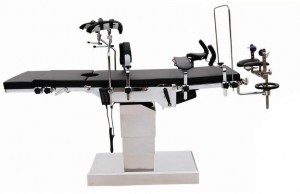Product Development

Last week I had the privilege of sitting in a doctor’s exam room for about 45 minutes with nothing to do. Next to me was an exam table (not the one shown above…) that brought back some old memories.
Back when I was in the machine building and integration business we used to do some work for Agile Engineering, a Knoxville company that builds a lot of products and devices for the medical field. They are a pretty high-tech company, as described in this crystal measurement application from a previous post.
In addition to their high tech custom machinery, they do design work for others and also occasionally develop their own OEM-type products. One of these was an adjustable medical table for use in a CT scanner. It had many of the features you might expect on one of these tables; controls to electrically adjust the elements of the table to different positions, manual adjustment of other elements, all contained in a package that would pass the rigid hospital grade requirements of the medical industry.
From an automation standpoint these tables are not very complicated. There are a few motors and gearing, some structural and stainless-steel components, padded cushions, axis overtravel switches and power/control wiring devices. No logic devices are required, just a few relays, switches and a disconnect. Wiring is not contained in a standard electrical enclosure, but built right into the frame.
The difficult part of developing these simpler products is the research into the market and in the case of medical devices, compliance and validation. Much more time is usually spent during the design phase than on a typical one-off custom job.
The other thing that I learned when developing my SmartBench was that just because you have developed a product doesn’t make it sell itself. I took the product to a couple of tradeshows and developed documentation and sales literature, but what with trying to run the rest of the company and being the only salesman I ran out of gas pretty quick. When developing a product for the market, it is very important to establish a considerable budget for sales and marketing.
Since I restarted my company last year I have done some consulting on product development. One application was a golf swing training device that was simply going to be too expensive and potentially dangerous for the public market. Another was a musical device that probably had some potential for sale, but no real budget for development, let alone marketing.
A much more reasonable application is one where a simple vacuum-formed plastic shape will be manufactured for sale through Home Depot. The developer had already identified a large customer and a manufacturer and just needed help on the details of production. This type of application tends to fund itself and is much less risky than some of the more high-tech products I have been involved in.
Because of the imminent release of my book and the need for shorter duration projects I will be doing much more consulting and yes, product development work over the next year. I am also always looking for good entrepreneurial projects and have several of my own underway (including resurrection of the SmartBench). Probably the biggest takeaway you should remember from this post is; whatever you think your development budget is for your product, double it. And don’t forget to take marketing and sales into account!
